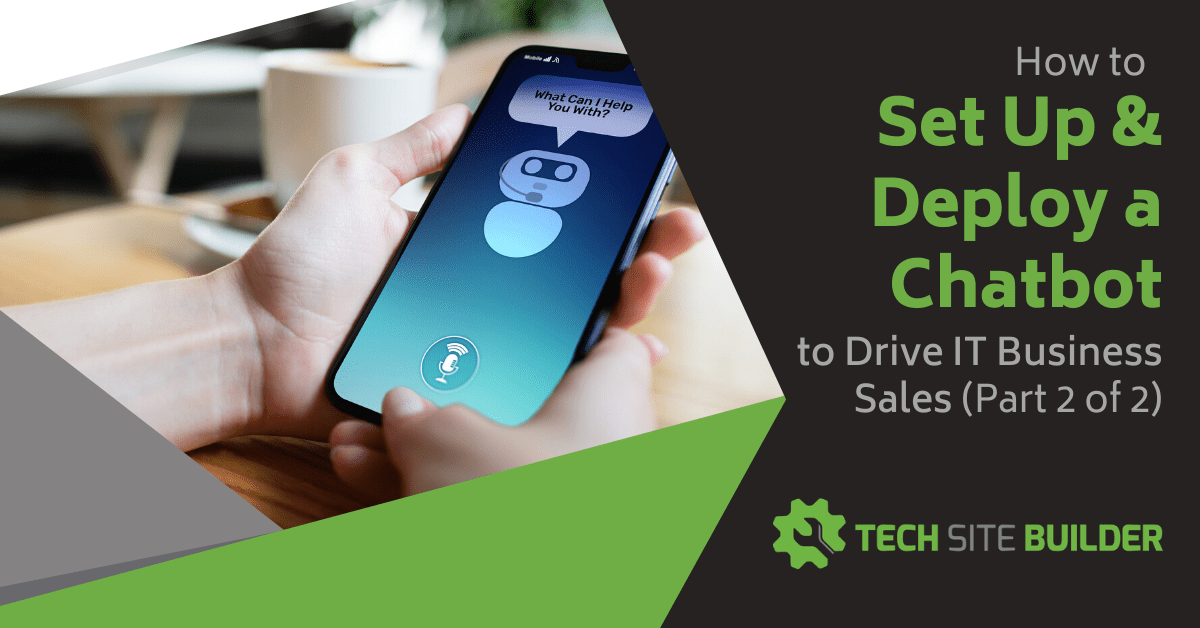
Being in the right place at the right time is often how you win a sale over a competitor. But if someone is looking at your custom computer build page at 2:00 a.m., how can you answer the questions they have right then to help them make a buying decision?
If set up correctly, chatbots can act as a tier 1 customer support person. It’s like having a salesperson and support rep working for you 24/7.
In this part 2 of our 2-part series on website chats we’ll go through the basics of how to properly set up and deploy a chatbot on your IT business site to get more leads and sales.
Won’t My Customers Hate a Chatbot?
First, let’s address the biggest fear of using a chatbot, which is that customers will hate getting an automated and unhelpful reply when they come on live chat.
If you don’t do a chatbot correctly, it’s true they can be frustrating. But done right, customers actually find them quite helpful.
80% of consumers that interact with a chatbot say they have a positive customer experience, and 69% prefer chatbots because they speed up the communication process.
So, chatbots not only save time for the MSP business owner, they do the same for customers that visit their site. That being said, 86% of people expect a way to escalate a chat to a live person if the chatbot can’t help. (We’ll discuss that more when we talk about setup).
People Are Getting Used to Automated Assistants
Another reason that customers are becoming more acclimated to chatbots is that they interact with them all the time. Think of how many people use Siri on their iPhone, Cortana on a Windows 10 PC, or Alexa on a smart speaker.
Automated assistants have gotten smarter and more helpful. They also have the ability to use more natural language than in the past.
If chatbots are set up well, then customers don’t hate them at all, they actually prefer them in many cases to a live person.
How Does a Chatbot Benefit Your IT Business Sales & Marketing?
The more power you can add to your IT business marketing engine, the better results you’ll get as far as leads and conversions. Many MSP business owners wish they had more time for marketing, but they’re tied up with customers.
Some of that tied up time is answering questions from people that visit their website. What if you could have someone else answer those questions – at least many of them – for you?
80% of customer chat sessions can be completely resolved by a chatbot.
Benefits of adding a chatbot to your website chat include:
- It can be in the right place at the right time to answer customer questions
- It frees you up from answering simple questions multiple times
- Increases sales and lead generation
- Lowers customer service costs by up to 30%
- Improves customer experience
Setting Up a Chatbot the Right Way
The biggest mistake business owners make when deciding to add a chatbot is thinking it’s going to be simple and take just a few hours. Those videos from chatbot software companies can make it seem so easy.
But if you go in thinking that, then you’re likely to become disillusioned, only set up a few basic questions and answers, and end up leaving your customers (and yourself) frustrated.
Chatbots can be incredible tools for sales and support, but you have to take the time to set up them up right.
This could take several weeks to get all the information in, but that doesn’t mean you can’t begin trying them out right away. Just include something like “Hi there, I’m still learning, so please forgive me if I don’t yet know an answer. I will soon!”
Here are the steps for properly setting up a chatbot.
Review Software to Decide Which Chatbot You Want
There are many different types of chatbot software out there, so you’ll want to review several of them and check out their reviews from other businesses that have used them.
Try going on a Facebook group, like Computer Business Marketing, to ask other MSP business owners what chatbot they use. This can shortcut your research process considerably.
Chatbot software considerations:
- Where you want to use it (website chat, Facebook Messenger, Twitter direct messages)
- Ability to integrate with the chat software you use
- How complicated it is to set up (go through a free tutorial if possible)
- Ease of use on mobile as well as desktop devices
Here are a few of the top chatbot apps you can check out:
Pull Historical Data to Create an FAQ Knowledge Base
You’ll want to start by putting together a knowledge base that will be input into your chatbot application. This will be the frequent questions that customers ask you and your team.
Pull these from your emails, CRM program, website chats, FAQ, etc. You want to write the question and then write out the answer. Include answers for all types of questions – both those that can and cannot be answered without your interaction.
For example, one common question might be: “What are your hours?” That’s an easy one to provide the full answer for using a chatbot.
Another question might be, “How much is a custom-built business workstation?” That’s not a question that has the same answer every time, but it still might be a common one you receive.
So, you would want to include an answer such as, “We price our custom builds based upon the specifications and features a customer is looking for. Please let me know as many details as possible about your needs and our team will reach out to you with a quote as soon as possible.”
The detail of this knowledgebase that you put together will directly impact how helpful your chatbot will be, and how many leads it can convert for you. You don’t have to do it all at once, add to it little by little, but make it as robust as possible.
Create A List Alternate Ways Questions are Asked
When you begin inputting your questions and answers into a chatbot, most will give you the opportunity to provide alternate ways that a question is asked. This helps avoid problems with a chatbot not recognizing a question that they have an answer programmed for.
For example, here are four different ways that a customer might ask about your operating hours:
- “What are your hours?”
- “When do you close?”
- “When do you open?”
- “Are you open on weekends?”
You want to include those alternatives in your chatbot knowledgebase. This is why it’s helpful to use your actual records of customer inquiries when building the knowledgebase, because that will give you the most common ways the same question is asked.
AI-powered chatbots are able to use your knowledgebase as well as customer interactions to learn as they go.
Configure an Escalation Hand-Off in Your Chat Settings
Chatbots will typically integrate with another program, for example Netomi connects with Zendesk Chat, to add a chatbot to your live chat interface.
Remember, people expect to be able to get help if their question goes beyond a chatbot’s capabilities. They will get frustrated if they keep getting, “I’m sorry I don’t know the answer to that” with no resolution.

Two ways that you handle the escalation hand-off are:
- During hours while you’re manning live chat: Configure an alert that sends the chat to a live agent with an appropriate message like, “Let me get a live agent to help you with that question, just a moment…”
- During non-business hours: Configure the ability to send a message to your email or CRM program and add a chatbot message like, “I’m sorry I can’t help with that question, I’ll be sending this to our customer support team and they’ll reach out to you as soon as they’re back in the office (link to your hours).”
Inject Your Brand & Personality
Chatbots are more personable than ever, and many of them come with “personality packs,” these can run the gamut from being formal and business-like to being more humorous and down to earth.
Everything from your chatbot’s name (George Bot, Bot Support, etc.) to its avatar can be used in to inject your brand personality and give your customers a cohesive experience with your IT business.
Use Links, Graphics, & Buy Buttons
You can use more than just text in an answer. Most chatbots will give you the ability to send answers back that include webpage links, graphics, and even purchase buttons.
Use this capability to it’s fullest to help drive more sales.
33% of customers say they like using chatbots to place orders or make reservations.
For example, look at these two options for answering the question, “What’s your cheapest MSP package?”
Answer 1: Our lowest priced MSP package is $49.99/month and includes (list of included items).
Answer 2: Our lowest priced MSP package is $49.99/month and includes (list of included items). You can click here to sign up and our team will contact you within 24 hours for your setup. (Buy link)
Answer 2 is more helpful and makes it easier for the person to purchase right then and there because it includes the buy link and reassurance someone will reach out soon.
Don’t Hide the Fact That It’s a Bot
If a customer thinks they’re talking to a real person and later finds out it’s a bot, they might feel tricked. There are even cases where less friendly website visitors that don’t like an answer that they get on chat from a live person will ask, “Are you a bot?!”
Be upfront about your chatbot by giving it a name that makes it clear that it’s not a live person. You can also include something in the bot’s intro that says, “I’m your friendly ACME Computer automated assistant, here to help! If there’s anything I can’t handle, I’ll get you to a live person that can. 😊”
Keep Your Bot Conversational & Inquisitive
When you’re inputting the knowledge base FAQ into your chatbot, remember to keep answers conversational and friendly. This is especially important to make your bot seem less “bot-like.”
A great function of a bot is to ask for more detail from a customer, just like you would yourself when pricing a job. Even if a bot can’t completely resolve a question, like “Can you do an emergency networking job this week?,” it can save you time by asking some important questions you need to know in order to estimate job timing.
Use your bot as needed to gather all types of information like:
- Email address
- Phone number
- Zip code
- Scope of a project
- And more
Optimize Your Bot Regularly
When you hire a new technician, they’re not going to know everything the first few weeks they work with you. They’ll continue to learn and get better as the months go by.
Think of your website chatbot in the same way. It’s not realistic to think you’ll get every possible answer to every question input right away. Start with those that get asked the most often and that have simple answers. Then continue adding to it and optimizing it over time to make it better.
Free Up More Time & Improve Customer Service
Do you wish you had more time during the day? Chatbots can reduce your load of call, chat, and email inquires as much as 70% by handling customer service for you. That’s more time for you and more instant answers for your customers.
Be sure to check out Part 1 of this series: “What Are the Benefits of Adding Live Chat to My Tech Business Site.”
What would you do for your MSP business if you had more time? Share in the comments.
Speak Your Mind